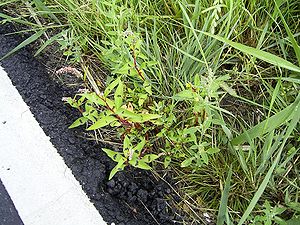Note: This is a project under development. The articles on this wiki are just being initiated and broadly incomplete. You can Help creating new pages.
Persicaria maculosa - Spotted lady thumb
Spotted lady's thumb or Persicaria maculosa (syn. Polygonum persicaria) is an annual plant in the buckwheat family, Polygonaceae. Common names include lady's thumb, spotted lady's thumb, Jesusplant, and redshank.[1] It is widespread across Eurasia from Iceland south to Portugal and east to Japan.[2] It is also present as an introduced and invasive species in North America, where it was first noted in the Great Lakes region in 1843 and has now spread through most of the continent.
Description
Persicaria maculosa is an annual herb up to 80 cm (31 in) tall, with an erect rather floppy stem with swollen joints. The leaves are alternate and almost stalkless. The leaf blades often have a brown or black spot in the centre and are narrowly ovate and have entire margins. Each leaf base has stipules which are fused into a stem-enclosing sheath that is loose and fringed with long hairs at the upper end. The inflorescence is a dense spike. The perianth of each tiny pink flower consists of four or five lobes, fused near the base. There are six stamens, two fused carpels and two styles. The fruit is a shiny black, three-edged achene. This plant flowers from July to September in the temperate Northern Hemisphere.[2][3]
Uses
- Persicaria maculosa contains persicarin and tannins. In medicine, redshank is used against diarrhoea and infections.
- The leaves and young shoots may be eaten as a palatable and nutritious leaf vegetable.
- A yellow dye can be produced from this plant with alum used as a mordant.
Common name
- English - spotted lady's thumb
